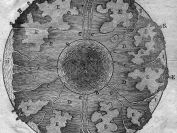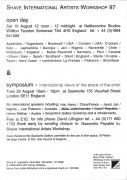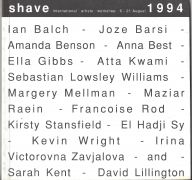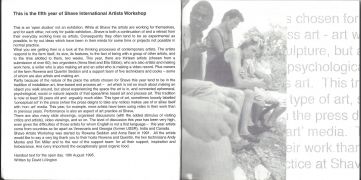In developing the Shave Workshop, Rowena Seddon and Anna Best were assisted by a large number of artists, including Tim Millar and Ella Gibbs. The Plasy Workshop was organized in collaboration with David Lillington.
SHAVE
Between 1991 and 1997, Shave Workshop took place at Shave Farm in Somerset. It was partially inspired by Pachipamwe Workshop in Zimbabwe. Shave developed its own character, influenced by the need for open debate and discussion between artists. However, in common with other workshops of the Triangle Network, Shave specifically focused on nurturing artists and their work. It formed a space where artists could be open and where they were not on public display.
In common with other workshops of the Triangle Network, Shave specifically focused on nurturing artists and their work. It formed a space where artists could be open and where they were not on public display. Because of this, the traditional distance between artist and audience was inherently questioned and the concerns of the workshops developed from the more object based to the site specific and collaborative.
Although a selection process (open and invited applications) was undertaken each year, the workshops were not curated in any traditional sense towards a coherent meaning. The aim was to enlarge existing networks for the benefit of all involved but primarily to create a space of exchange, questioning and open ended collaboration, with unknown or invisible results.
A two week period is a generous amount of time and provides space for ongoing convoluted and experimental conversation to happen. It allows the conjunction of individual exploratory processes and ideas mingling with discussion of broader issues of globalisation and its effects on art making, economic position of artists in different cultures, political role of artists in society etc· It is a space where literally theory, history and practice come together.
The group of participants (approximately 15 each year) were making work on site and in a sense suddenly finding themselves in an open plan (open sky) shared studio space. Shave could be thought of as a self organised temporary art school or university where everyone is a teacher and a student. Someone described it as ·perfectly organised anarchy· but in its brevity it offered something an institution could not possibly offer. It is out of the shadow of the art-marketplace, the academic institution and away from the pressure to constantly produce or succeed; a place where communication can fulfil its potential.
Ella Gibbs is British visual artist (born and is based in London). Selected projects include: Last Dance, Annely Juda Fine Art, London (2003); Campaign for Spare Time, Art of Survival, Prague Biennale (2003); Fish Island - The Making of a Radio Show, Space Studios, London (2002); Horse Collection on Tour, TENT, Rotterdam, The Netherlands and John Hansard Gallery, Southampton (2002). Group exhibitions include: Potential, Ongoing Archive, John Hansard Gallery, Southampton (2001); Programme - a series of planned projects and incidental events, for Temporary Accommodation, Whitechapel Art Gallery, London (2001); Night Stop Cinema, River Lea Valley, commissioned by London Musicians Collective, London (2001).
David Lillington is a writer and a curator. Alongside other things, he has since 2009 been researching art and death. He is a member of the ASDS (Association for the Study of Death and Society), for which he has presented papers at their affiliated Death Dying and Disposal conferences since 2009. He will next present a paper in May 2017 at the Death and the Maiden conference in Łódź (Faculty of English, University of Social Sciences). Recent writings include ‘Death Ltd.’ for Art Monthly, a chapter on the ‘Ideal Death’ paintings of Keti Kapanadze, for a monograph launched at the Georgian Embassy in London in February 2017. In 2016 he presented a paper on Elizabeth Price at the conference Death and Culture, University of York. In 2014, he was curator the exhibition Death and Dying at MAG3 in Vienna and in 2012 he was Curatorial Advisor for Death: A Self-Portrait (Wellcome Collection). Artists’ videos screened for the events programme were re-screened in London and in Vorarlberg, Austria (2015).








